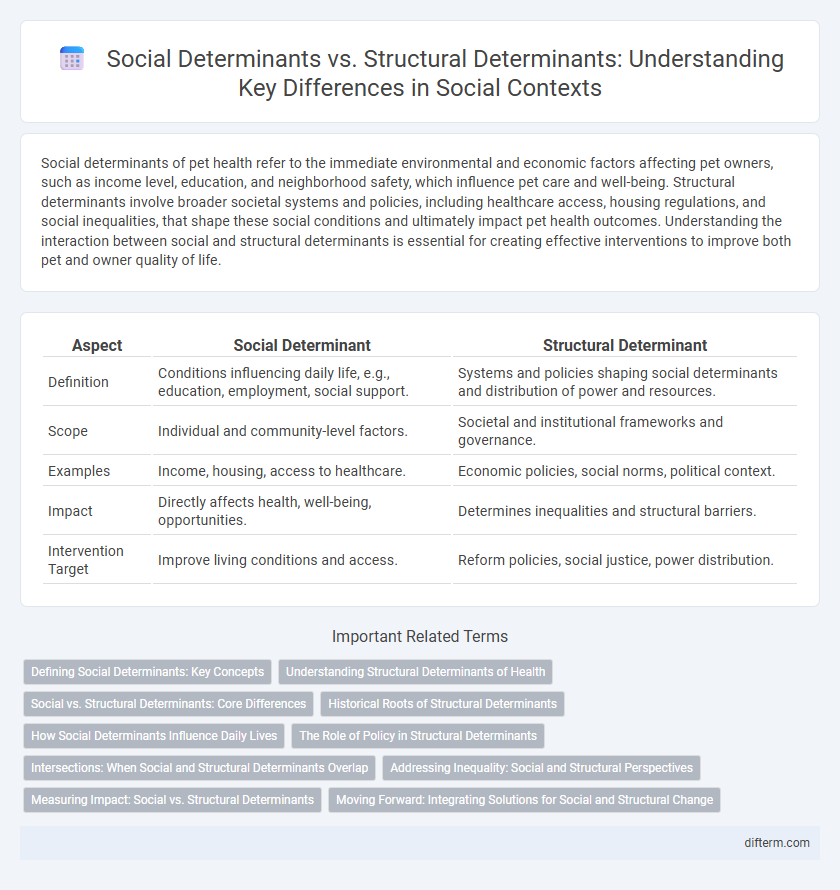Social determinants of pet health refer to the immediate environmental and economic factors affecting pet owners, such as income level, education, and neighborhood safety, which influence pet care and well-being. Structural determinants involve broader societal systems and policies, including healthcare access, housing regulations, and social inequalities, that shape these social conditions and ultimately impact pet health outcomes. Understanding the interaction between social and structural determinants is essential for creating effective interventions to improve both pet and owner quality of life.
Table of Comparison
| Aspect | Social Determinant | Structural Determinant |
|---|---|---|
| Definition | Conditions influencing daily life, e.g., education, employment, social support. | Systems and policies shaping social determinants and distribution of power and resources. |
| Scope | Individual and community-level factors. | Societal and institutional frameworks and governance. |
| Examples | Income, housing, access to healthcare. | Economic policies, social norms, political context. |
| Impact | Directly affects health, well-being, opportunities. | Determines inequalities and structural barriers. |
| Intervention Target | Improve living conditions and access. | Reform policies, social justice, power distribution. |
Defining Social Determinants: Key Concepts
Social determinants refer to the conditions in which people are born, grow, live, work, and age, including factors such as education, income, and social support. Structural determinants encompass the broader societal systems and policies, like economic structures, political institutions, and social norms, that shape these living conditions. Understanding the distinction between these determinants is crucial for addressing health inequities and promoting social justice.
Understanding Structural Determinants of Health
Structural determinants of health encompass the overarching social, economic, and political systems that shape health inequities by influencing living conditions, access to resources, and power dynamics within a society. These determinants include factors such as government policies, socioeconomic status, education systems, and labor markets, which collectively determine the distribution of health opportunities and risks. Understanding structural determinants is essential for addressing root causes of health disparities rather than merely treating symptoms linked to individual or social determinants.
Social vs. Structural Determinants: Core Differences
Social determinants of health encompass conditions like education, income, and social support that directly influence individual well-being. Structural determinants refer to the systemic and institutional factors such as policies, governance, and socioeconomic systems shaping social determinants and creating health inequities. Understanding the interplay between social and structural determinants is crucial for designing effective health interventions and promoting equitable outcomes.
Historical Roots of Structural Determinants
Structural determinants of health stem from historical processes such as colonialism, slavery, and systemic racism that created and perpetuated unequal power relations and resource distribution. These historical roots shape social hierarchies and institutional policies, influencing access to education, housing, healthcare, and employment opportunities. Understanding the legacy of these structural determinants is essential for addressing health disparities beyond individual lifestyle or social factors.
How Social Determinants Influence Daily Lives
Social determinants such as income, education, and neighborhood conditions directly impact individuals' access to healthcare, nutrition, and employment opportunities, shaping their daily experiences and overall well-being. These factors determine the quality of housing, exposure to environmental hazards, and social support networks, influencing physical and mental health outcomes. Understanding social determinants is essential for addressing health disparities and promoting equitable social policies.
The Role of Policy in Structural Determinants
Policy plays a crucial role in shaping structural determinants by influencing social, economic, and environmental conditions that impact population health. Structural determinants include factors such as governance, policies, and cultural norms that create and sustain social hierarchies and inequities. Effective policy interventions can address root causes of health disparities by reforming systems related to housing, education, labor, and healthcare access.
Intersections: When Social and Structural Determinants Overlap
Social determinants such as education, income, and social support intersect with structural determinants like policies, institutional practices, and systemic racism to create compounded effects on health and wellbeing. These overlapping factors amplify disparities by reinforcing barriers in access to resources, opportunities, and healthcare. Understanding their intersection is crucial for developing targeted interventions that address both immediate social needs and underlying structural inequalities.
Addressing Inequality: Social and Structural Perspectives
Addressing inequality requires understanding the distinction between social determinants, such as income, education, and social support networks, and structural determinants, which include systemic policies, institutional practices, and power dynamics shaping resources distribution. Effective interventions target both immediate social conditions and underlying structural factors to promote equity and social justice. Comprehensive strategies integrating education reform, healthcare access, and economic policy changes can reduce disparities and foster inclusive development.
Measuring Impact: Social vs. Structural Determinants
Measuring impact between social and structural determinants requires analyzing data on factors such as income, education, housing, and systemic policies that shape access to resources and opportunities. Social determinants focus on immediate conditions influencing health outcomes, while structural determinants encompass broader societal frameworks like economic systems and institutional racism driving inequalities. Quantitative metrics and longitudinal studies reveal how changes in policy and social environment differentially affect population health disparities.
Moving Forward: Integrating Solutions for Social and Structural Change
Addressing health disparities requires a comprehensive approach that integrates social determinants such as income, education, and housing with structural determinants like policies, institutional practices, and systemic inequalities. Moving forward, strategies must prioritize cross-sector collaboration to dismantle structural barriers while simultaneously improving social conditions. Evidence shows that coordinated interventions targeting both levels foster sustainable social change and promote equity across communities.
social determinant vs structural determinant Infographic

 difterm.com
difterm.com